|
|
ARTHROPODS:
Insects»
Spiders»
Centipedes»
Millipedes»
Sowbugs»
Harvestmen»
Mites
& Ticks»
Scorpions»
Identification
Tips»
About
the Critter Files»
Links» |
|
|
|
 |
LADY
BEETLES
Critter
Files/Insects/Beetles/Lady
Beetles
By Blake Newton
University of Kentucky Department of Entomology |
| |
|
| Common
Kentucky Lady Beetles: |
| |
| TAXONOMY |
KINGDOM:
Animalia | PHYLUM: Arthropoda | CLASS: Insecta | ORDER:Coleoptera
| FAMILY: Coccinellidae (lady beetles) |
| |
| Other
Names: Ladybugs, Ladybird Beetles, Ladybirds, Coccinellids |
| |
WHAT
IS A LADYBEETLE?
LIFE CYCLE
ECOLOGY
PEST STATUS
COMMON KENTUCKY LADYBEETLES
COLLECTING & PHOTOGRAPHY
LADY BEETLE FACTS
MYTHS, LEGENDS, AND FOLKLORE |
| |
| WHAT
IS A LADY BEETLE? |
|
Like all
beetles, Lady Beetles (often called "ladybugs"
or "ladybird beetles") have chewing mouthparts and hardened
front wings (elytra) that fold over the abdomen to proect their
back wings. Lady beetles always have round or broad, oval
bodies, and most species are orange, red, or yellow, with black
spots. A few rare types are black with yellow, orange, or
red spots, and some are completely black. The ends of lady
beetle antennae have small clubs.
Lady beetle larvae are
elongated, and most are black with yellow, red, or orange markings.
The larvae of a few species produce a thick wax coating over
their bodies. |
|
| SIZE:
Adults and larvae up to 3/8" |
| |
| LIFE
CYCLE |
|
|
| Lady
beetles have complete metamorphosis with egg, larval, pupal, and
adult stages. In most ladybird beetle species, bright yellow
or orange eggs are laid in small clusters which are glued to plant
leaves with secretions produced by the female. The larvae
hatch within a few days and reach full size after 2 molts, a time
span of about a month (depending on temperature, food availability,
and species).
|
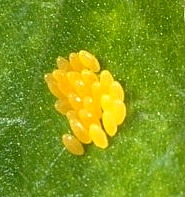
Lady Beetle Egg Cluster
(R. Bessin, 2000) |
| |
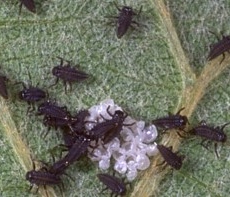
These 1st instar (newborn) lady beetle larvae
are less than 2 mm long (R. Bessin, 2000) |
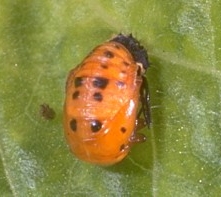
Pupa of Convergent Lady beetle
(R. Bessin, 2000) |
| |
| The larvae
then pupate, and emerge as adults after a few days. Most species overwinter
as adults in large underground or sheltered colonies. There
are several generations each year. |
| |
| ECOLOGY |
|
| |
There are
several species of lady beetles in Kentucky. Some are predatory,
and some are plant feeders, and each type has a different ecological
role. Many lady beetles have defensive secretions that make
them taste bad to predators. Even with this protection, lady
beetles are often eaten by birds, spiders, and larger insects.
PREDATORY LADY
BEETLES: Predatory lady beetles are the most common. The
larval and adult forms of predatory lady beetle species feed on
a wide variety of small, soft-bodied insects, such as aphids, scale
insects, caterpillars, other insect larvae (including other lady
beetle larvae), and insect eggs. Both the adults and larvae
actively hunt for prey over the surfaces of plants, especially in
weedy environments and in crops. Pictured below are two predatory
lady beetle larvae. On the left is Hippodamia
convergens, a common aphid predator in Kentucky agricultural
habitats. On the right is a larva from the Scymnus
genus. This larvae also feeds on aphids. The white tufts
covering the larva are made of a waxy substance that is secreted
from pores on the insect's skin. The substance helps to protect
the larva from ants and other predators. Ezra Schwartzberg,
a former researcher at the University of Kentucky Department of
Entomology, studied the complex ecological relationships between
Scymnus larvae, the aphids that the larvae prey on, and
the ants that protect the aphids.
|
| |
|
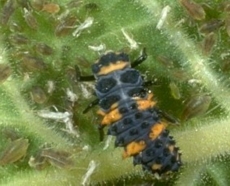
Convergent Lady Beetle Larva, feeding on
aphids
(R. Bessin, 2000) |
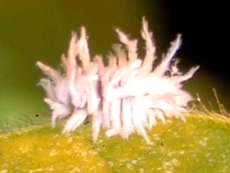
Lady beetle larva from the Scymnus
genus
(E. Schwartzberg, 2002) |
| |
| PLANT-FEEDING
LADY BEETLES: Plant-feeding lady beetles are normally larger
than predatory lady beetles. We only have a few species of plant-feeding
lady beetles in Kentucky. The larvae and adults feed on the
leaves of a variety of legume plants. |
| |
| |
| |
| COMMON
KENTUCKY LADYBIRD BEETLES |
|
|
ASIAN
LADY BEETLE
GENUS and SPECIES:
Harmonia axyridis
The Asian Lady
Beetle, Harmonia axyridis, was imported into the
United States to control aphid pests. The beetle kills lots
of aphids, but it also overwinters in huge numbers inside homes
This species also attacks other lady beetle larvae and eggs,
and may be responsible for reducing numbers of native lady beetle
species. The Asian Lady Beetle can be difficult to identify
because it has a highly variable number of spots. Read more
about this pest in our Asian
Lady Beetle factsheet. |
| |
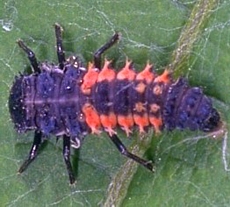
Asian Lady Beetle Larva (R. Bessin, 2000) |
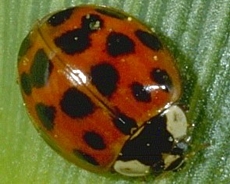
Asian Lady Beetle (R. Bessin, 2000) |
|
|
|
MEXICAN
BEAN BEETLE & SQUASH LADY BEETLE
GENUS and SPECIES:
Epilachna varivestis (mexican bean beetle), Epilachna
borealis (squash lady beetle)
The Mexican Bean
Beetle, Epilachna varivestis, pictured below left,
is a large plant-feeding lady beetle. It will sometimes causes
injury to bean crops in Kentucky. A close relative, the Squash
Lady Beetle, Epilachna borealis, below right,
is an occasional pest as well. These beetles are more serious
pests further south. Read more about them here
at the University of Florida Featured Creatures web page.
|
| |
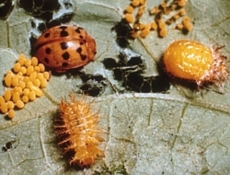
Eggs, larva, pupa and adult Mexican Bean
Beetle
(R. Bessin, 2000) |
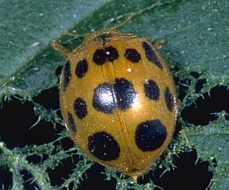
Squash Lady Beetle (R. Bessin, 2001) |
|
|
|
SEVEN-SPOT
LADY BEETLE
GENUS
and SPECIES: Coccinella septempunctata
CONVERGENT LADY BEETLE
GENUS and SPECIES:
Hippodamia convergens
PINK
LADY BEETLE
GENUS
and SPECIES: Coleomegilla maculata
Pictured below are the Seven-Spot
Lady Beetle, the Pink Lady Beetle (also
called the 12-Spotted Lady Beetle), and the Convergent Lady
Beetle. These are some of the most common beneficial
predatory lady beetle species that are frequently encountered in gardens,
crops, and meadows. |
| |
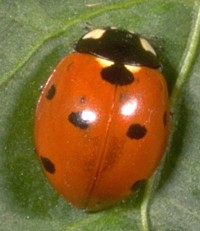
Seven-Spot Lady Beetle (R. Bessin, 2000)
|
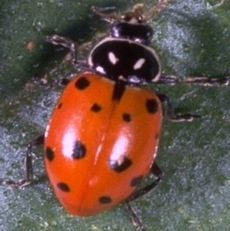
Convergent Lady Beetle (R. Bessin, 2000)
|
| |
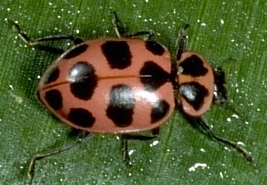
Pink Lady Beetle (R. Bessin, 2000)
|
|
|
|
YELLOW-SPOTTED
LADY BEETLES
GENUS:
Hyperaspis
Not all lady beetles are
red with black spots: some are black with red, orange, or yellow spots,
like the Hyperaspis sp. pictured below. Most of the
beetles in this genus are predators. |
| |
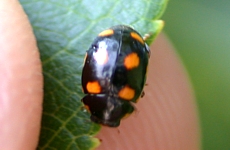 Yellow-spotted
Lady Beetle (B. Newton, 2002)
Yellow-spotted
Lady Beetle (B. Newton, 2002) |
|
| |
| COLLECTING
& PHOTOGRAPHY |
|
Lady beetles and their
larvae are common and easy to find in Kentucky during summer and
early fall, especially on garden plants and in crops where they
can be found hunting on leaves for aphids and other small insects.
The beetles are typically slow-moving and easy to catch, but
they will sometimes drop off of a plant to escape danger. They
are also able to fly, but they are slow, clumsy fliers. The
larvae are very slow-moving and easy to capture. Remember
that all insect larvae should be preserved in alcohol.
The larvae will often
remain still long enough for you to snap a picture, but the adult
beetles seem to be in constant motion, especially on hot days. To
take a good picture of any insect, it is sometimes a good idea to
"cool it off" first. To do this, capture the insect
and place it in a refrigerator for fifteen minutes or so. This
will not kill the insect (unless your refrigerator is very cold!),
but it will cool it down enough so that it will remain motionless
while you take its picture. In a few minutes, the insect will
be back to normal.
|
| |
| MYTHS
- LEGENDS - FOLKLORE |
|
It is often said that
it is bad luck to kill a ladybug. In fact, many people believe
that ladybugs are lucky. This is even mentioned in the Four
Seasons song, "Lucky Ladybug," from 1963.
It is believed in Europe
that the number of spots on certain lady beetle species can predict
the coming harvest: fewer spots is good, too many spots is bad (this
is probably not true, by the way!). |
Original document: 25 May 2004
Last updated: 25 May 2004
Photos courtesy R. Bessin and B. Newton, University of Kentucky
The Kentucky Critter
Files are maintained by Blake Newton, Department of Entomology, University
of Kentucky.
Contact: blaken@uky.edu
|
|

